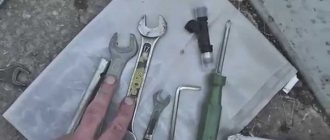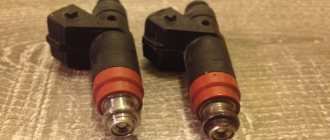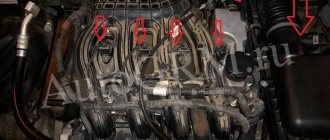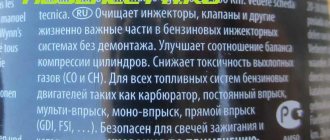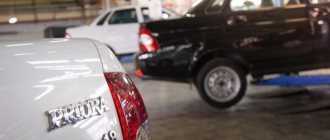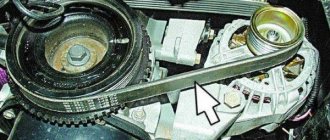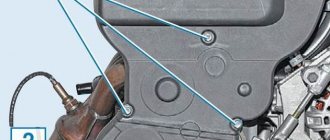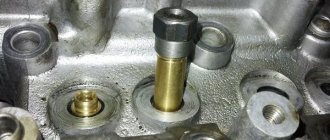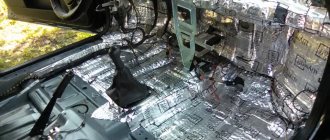Replacing injectors on a Lada Priora car
Before we move on to describing the process of removing the injectors, you need to select everything you need for the job. Here is a list of tools and consumables:
- Phillips screwdriver;
- set of hex keys;
- set of open-end wrenches;
- pliers;
- wrench and set of socket heads;
- flat screwdriver.
Sequence of work
- The block to which the wires of the Priora injectors are connected is manually disconnected and removed.
The block with wires on the Priora fuel rail is removed manually
The mounting fuel rail on the Priora can only be unscrewed with a Phillips screwdriver
The Priora fuel fitting should be unscrewed with only two keys
The O-rings from the Priora ramp should be removed so as not to lose them
The Priora ventilation hose can only be removed after loosening the clamp
It is convenient to loosen the Priora brake hose clamp with pliers
The Priora intake pipeline is held on top by only two nuts
After unscrewing the fasteners, you can simply pull the Priora pipeline towards you
Two 5-point screws on the Priora ramp can only be unscrewed with a hexagon
The Priora fuel rail is removed along with injectors and wires
The injector on the Priora can be unscrewed from the ramp manually
Cleaning injectors with ultrasound
And another method that can be easily used to clean them is ultrasound.
Pros and cons of using ultrasound
There is still debate about how useful this method is, and there is no consensus on this. Some say that this method harms the injectors due to the destruction of the mesh, and that such work should only be combined with washing and dismantling. Others say that such work has a very good effect on the condition of the injectors and does not harm them in any way; moreover, the condition of ultrasonic cleaned injectors is comparable to new parts.
In any case, it is up to you to decide whether to use this method. The cost of such work at a car service is 2,000 rubles and takes about 4 hours.
Replacing injectors on a Lada Priora car
Before we move on to describing the process of removing the injectors, you need to select everything you need for the job. Here is a list of tools and consumables:
- Phillips screwdriver;
- set of hex keys;
- set of open-end wrenches;
- pliers;
- wrench and set of socket heads;
- flat screwdriver.
Sequence of work
- The block to which the wires of the Priora injectors are connected is manually disconnected and removed.
The block with wires on the Priora fuel rail is removed manually - Now use a Phillips screwdriver to unscrew the screw holding the pressure plate of the fuel pipe.
The mounting fuel rail on the Priora can only be unscrewed with a Phillips screwdriver - Use a 17 wrench to unscrew the fuel pipe fitting.
In this case, the tip of the tube must be held with a key at “22”, preventing it from turning. Without this, the fuel rail may break. The Priora fuel fitting should be unscrewed with only two keys - The fuel pipe is carefully removed from the ramp, and the sealing rings are removed from it.
The O-rings from the Priora ramp should be removed so as not to lose them - Use a Phillips screwdriver to loosen the clamp on the crankcase ventilation hose.
The hose is then manually disconnected from the cylinder block. The Priora ventilation hose can only be removed after loosening the clamp - The tube with lubricant level indicators is removed.
- There is a hose on the intake manifold that goes to the vacuum brake booster.
The clamp on this hose is loosened with pliers. It is convenient to loosen the Priora brake hose clamp with pliers - Use a socket head to “10” to unscrew a pair of nuts on the fastenings of the intake pipelines.
The Priora intake pipeline is held on top by only two nuts - Then, using a “13” head, unscrew all the bolts on the lower fastening of the pipelines.
- The pipeline, freed from the fasteners, is slightly lifted up and pulled towards itself. Access to the fuel rail is provided. After unscrewing the fasteners, you can simply pull the Priora pipeline towards you
- The ramp is held on the cylinder block by two screws at “5”.
They can only be unscrewed using a hex wrench. Two 5-point screws on the Priora ramp can only be unscrewed with a hexagon - After this, the ramp is removed from the cylinder block along with the injectors and wires.
The Priora fuel rail is removed along with injectors and wires - Old injectors are unscrewed from the ramp and replaced with new ones.
The injector on the Priora can be unscrewed from the ramp manually - After this, the fuel system is reassembled.
How to check for faults
The car owner can independently check the performance of the injectors on his car. The procedure is quite simple and does not require special training or expensive equipment. In garage conditions, diagnostics can be performed with a set of open-end wrenches, screwdrivers and a tester with a resistance measurement mode.
Reasons indicating problems
Diagnostics must be performed not after any period of operation or mileage has expired, but in the presence of external manifestations of injector failures. In cases where other vehicle systems are operating normally, the following indicators indicate problems with the injection solenoid valves:
- at idle there is instability in engine speed;
- starting the engine is difficult - the engine may stall;
- when overclocking it is impossible to achieve the same dynamics;
- The amount of fuel consumed has noticeably increased.
Diagnostic procedure
- Open the hood.
- Unclip the plastic clips that secure the valve's power cable. Remove the connector.
- Switch the tester to resistance measurement mode and take measurements of the windings of each of the injectors in turn. That is, you need to apply one contact of the tester to each of the five terminals, and the second one to the fifth wire for power.
- Optimal resistance values in all cases should be in the range of 11–15 ohms. If at least one pin shows deviations, it will be necessary to change the nozzle.
How to wash injector nozzles with your own hands
As practice shows, in order to achieve the best results at home, you need to assemble a small stand. Any driver can do this. Even if you have no experience, the work will take a little time. Required:
- A bottle or other plastic container with a capacity of about 500 ml.
- Nipple – 2 pcs.
- Screwdriver and drill for the outer diameter of the nipple.
- 4 test tubes or tall containers for collecting the cleaning composition.
- 12 V power supply or battery.
- A piece of rubber hose and clamps to secure it.
- Solvent.
First, assemble an improvised stand:
- Select a sheet of any material of a suitable size on which you can fix the ramp. To do this, mark the surface and drill holes in the required places for fastening with bolts.
- The container for the cleanser also needs to be prepared. To do this, one nipple is installed in the plug, and a second one in the bottom; they need to be fixed securely. The easiest way is to use a sealant.
- The bottle is placed upside down, attach a hose to the lower nipple, the second end of which is connected to the ramp. Tighten the connections with clamps so that they are reliable and do not leak liquid.
- Assemble a system from wires and a power supply or battery. Connect all injectors in parallel. It is best to include a button in the system that is activated when pressed. Test operation without adding product. If everything is normal, characteristic clicks will be heard in the injectors.
For cleaning, you can use either a special product or Dimexide. Usually you need about 500 ml or more. The duration of cleaning is determined as you go. Instructions for carrying out work:
- Pour the liquid into the container and carefully connect the connections.
- Using a compressor or pump, pump up the pressure in the system through the second nipple to two atmospheres.
- Use the button to open and close the nozzles so that the cleaning agent passes through them under pressure. The liquid will enter the container from below; the degree of contamination can be determined by its condition.
- Continue working until the torch in all elements becomes uniform and finely dispersed.
- To flush the system from residual cleaning agent, fill in Solvent and also pass it under pressure for a couple of minutes.
By the way!
To clean the outside, you can place the nozzles in a cleaning solution without submerging the rubber seals. If possible, remove them and replace the rubber rings with new ones.
Replacing injectors on a 16-valve Lada Priora engine
As mentioned above, symptoms of injector malfunction include unstable engine operation, starting problems and increased gas mileage. To change the nozzle to a new element, you will have to spend a lot of time, since the replacement procedure is quite complicated.
As a working tool, it is recommended to immediately prepare:
- set of heads;
- set of open-end wrenches;
- Phillips-blade screwdriver.
After the car has stood for some time and cooled down, you can start working:
- The plastic retainer of the harness must be pressed to the side with your finger to pull the bundle of wires out of the injector.
- After which you will need to relieve the pressure in the car’s fuel system. The average pressure is approximately 380 kPa, that is, if work is carried out without bleeding, you can get injured due to sudden fuel emissions. To do this, you will need to open the rear door of the car and remove the seat from the back row.
- There is a carpet under the seat, and under it there is a hatch to the gas tank.
- Using a Phillips screwdriver, unscrew the two screws that secure the hatch cover to the panel and remove the cover.
- From the fuel pump, which is located in the gas tank, you need to disconnect the power wire - the connector can be pulled out without difficulty.
- After this, you need to start the car and wait until the engine stalls due to lack of gasoline.
- Next, you need to run the starter for at least three seconds so that the pressure in the system equalizes.
- Disconnect the cable from the negative terminal on the battery.
- After which the procedure for removing the injectors is possible without risk. To begin, use a screwdriver to unscrew the decorative box on the engine.
- Next, remove the screws securing the air filter box from the car body - it will prevent free access to the engine, so it is better to remove it immediately.
- The wire connected to the throttle valve is disconnected from the intake manifold.
- Next, you will need to disconnect all the lines that connect directly to the frame connectors. It will be necessary to prepare to remove the fuel frame - to do this, use a 10mm wrench to unscrew the bolts that secure the frame to the body.
- Using a screwdriver, loosen the clamps on the ventilation and vacuum hoses and disconnect the hoses from the cylinder block.
- The intake manifold is bolted to the cylinder head with three nuts - you will need to unscrew them to remove the intake manifold.
- After which it will be possible to disconnect the injector harness.
- The fitting through which fuel is supplied is disconnected from the engine compartment.
- After this, you can remove the fuel pipe from the frame, and then dismantle the fuel frame along with the injectors that are located on it.
- The injectors can be pryed off with a screwdriver - the fixing element is easily removed so that you can get to the valve itself.
Video: removal procedure
Thus, dismantling the injectors takes quite a lot of time, since you have to disassemble almost the entire engine compartment of the car. Installation of new injectors is carried out in the reverse order with the obligatory replacement of all rubber seals.
Prices for cleaning injectors
- In order to clean the injectors that have been removed and fixed on the ramp, you will need a total cost of about 500 rubles .
- And to clean them in the service, you will pay about 2000 rubles , and this is the same as when cleaning with ultrasound.
Since such work does not pose any difficulty, it is much easier to do everything yourself.
Injector prices
If, after the cleaning and diagnostic procedure, you come to the conclusion that it is completely faulty and needs to be replaced, then it is worth noting that you should buy a strictly analog nozzle, with the part number indicated on its body. The average price for them is in the range of 1000-1500 rubles.
Injectors installed on Priora
The Lada Priora car is equipped with imported injectors manufactured by the German company BOSCH. These devices are highly reliable. Their service life can reach 160 thousand kilometers. However, car service specialists strongly recommend changing injectors every 120 thousand km.
Almost all Prioras are equipped with German injectors from BOSCH
Injectors for 8 and 16 valve engines
You should know that the injectors of the 8-valve Priora engine are no different in appearance from the injectors of the 16-valve engine. These are all the same devices from BOSCH, consisting of a housing, a coil, a diffuser and a fuel grid. When choosing injectors for a Priora, you need to think not about the number of valves in the engine, but about its volume. Because the markings of injectors for 1.5 liter engines are different from the markings of injectors for 1.6 liter engines. In the first case, the BOSCH injector should be marked 0-280-158-110, in the second - 0-280-158-502. You can clarify the markings in the car’s operating instructions, at the end of which there is a summary table with digital designations of all BOSCH injectors depending on engine size.
Table of applicability of injectors for VAZ cars
Why do injectors clog?
Clogging is caused by the way the injectors operate. Of course, using low-quality fuel accelerates the process of deposit formation. But even the highest quality gasoline does not guarantee that over time the injectors will not begin to clog. The most unfavorable period is a few minutes after the engine has been turned off.
The injector body begins to get very hot from the engine. The process is further intensified due to the fact that the elements are not cooled by the passing air-fuel mixture, which is supplied to the cylinders during movement. Very high temperatures cause the evaporation of light fractions of fuel remaining in the system. And heavy fractions settle on surfaces and form a coating that is not dissolved by gasoline and is not washed off during further work.
Over time, the thickness of the deposits becomes such that it disrupts the normal operation of the system. The injectors do not spray, but pour fuel, the valve does not operate correctly. Manufacturers recommend changing parts every 120-140 thousand kilometers.
INJECTOR SET BOSCH 017 FOR LADA KALINA, PRIORA, CHEVROLET NIVA
Statistical flow at 3 bar, average n-Heptane - 105.7 g/min
Resistance - 12 Ohm
Fuel preparation - gasoline injection
The price is per set!
Catalog number: 0 280 158 017
Manufacturer: BOSCH
Specifications:
Statistical flow at 3 bar, average n-Heptane - 105.7 g/min
Resistance - 12 Ohm
Fuel preparation - gasoline injection
The price is per set!
Catalog number: 0 280 158 017
Manufacturer: BOSCH
Payment to Sberbank VISA card
The most convenient and profitable payment method for you. Payment can be made through the Sberbank Online system, through a payment terminal (Sberbank ATM), provided that you have a card from this bank. If you are not a client of this bank and you do not have a card, then you can top up your balance at any bank branch through an operator; they will accept cash payment and top up your balance. Commission from 0 to 1%
Cash on delivery (payment upon receipt)
Payment for the order will be made at the post office upon receipt of the goods. For cash on delivery services, Russian Post takes an additional commission - approximately 4% of the cost of the order (parcel) upon receipt.
The postal commission based on the amount of “Cash on Delivery” for your parcel is described below, i.e. In addition to the delivery cost, the post office will also charge you a commission for .
Postal commission for cash on delivery service:
· up to 1,000 rub. inclusive - 80 rub. + 5% of the amount
· over 1,000 to 5,000 rubles. inclusive - 90 rub. + 4%
· over 5,000 rub. up to 20,000 rub. inclusive -190 rub. + 2%
· over 20,000 rub. up to 500,000 rub. inclusive - 290 rub. + 1.5%
Attention! Advance payment for delivery 100% (via Sberbank payment). This is included in our Cash on Delivery terms and conditions.
Check with the manager for additional information.
Yandex money. This payment method involves issuing an invoice in the Yandex.Money system. You can pay from your Yandex.Money wallet
ATTENTION! There are restrictions on the payment amount: anonymous wallet 15,000 rubles, registered wallet 60,000 rubles, identified wallet 250,000 rubles. After payment you will receive an electronic cash receipt
QIWI Wallet. This payment method involves issuing an invoice in the QIWI system. You will be able to pay from your QIWI wallet
ATTENTION! There are restrictions on the payment amount: RUB 250,000. After payment you will receive an electronic cash receipt
Attention! Regardless of which delivery method you choose, check the integrity of the goods and packaging upon receipt of the cargo (parcel)
Delivery by Russian Post (payment by Sberbank)
Russian Post (payment upon receipt)
Post EMS (courier)
EMS company
is a division of Russian Post, part of the global EMS (Express Mail Service) system. Express delivery worldwide.
Purification process
Cleaning the nozzles itself should be done on a clean surface - for this you can cover the working surface with a piece of cloth.
Prepare a hose and a can for cleaning the carburetor. To flush, secure a plastic hose clamp at the inlet of the nozzle (make sure the length is at least 20 cm). The nozzle will need to be turned on, and the end of the hose itself will need to be lowered into the liquid that is used to flush the carburetor. Cleaning can be carried out by any of the proposed ones - RunWay, Liqui Moly or Hi-Gear.
But there is no need to add cleaning additives advertised on the market to the fuel: it very often happens that they harm the engine. The acidified dirt itself after such cleaning can create a blockage that will prevent normal access to the fuel-air mixture. Otherwise, fuel access may be blocked.
Cleaning is complete. Now do the installation in reverse order.
I decided to start cleaning the injectors on my car. The car ran no less, but so to speak, I decided to do preventive maintenance on cleaning the injectors on my car. The whole purchase began with Wynn's injector flushing fluid 1
Wynn's flushing liquids are used for washing injector nozzles without dismantling, cleaning the cylinder-piston group (partial removal of carbon deposits from the cylinder walls and sealing rings) as well as the exhaust system without harming the catalytic converter.
And since I did not want to remove the injectors from the engine, this was the flushing fluid that suited me as a flush. I once found information on the Internet about cleaning injectors in this way and decided to do the same operation without removing the injectors on my car. In general, for this I needed to buy some things that were necessary for this DIY flushing device. For this I needed:
For this I needed. 1. Flushing liquid 1l. 2. Fuel filter. 3. Clamps 2 pcs. 4. Two nipples. 5. Hose 12mm -1 meter. 6. Two liter bottle. 7. Drill 13 8. Compression pump
Flushing liquid 1l
What does cleaning injectors do?
Timely action to return the injector to its original appearance provides the following advantages:
- the original fuel spray pattern will be restored;
- the formation of the fuel mixture will improve;
- engine efficiency will increase;
- fuel consumption will decrease;
- the engine will stop running.
Removing injectors on Priora (Lada 2170, VAZ 2112)
Thank you so much for watching my videos, tell your friends, leave comments and subscribe...
Cleaning injectors on a Priora without removing it (quickly and cheaply)
Washing is HERE...
What injectors are installed on Priora cars?
Injectors are an indispensable element in the operation of any power unit with continuous injection. Structurally, they are electromagnetic valves, which, when opening, ensure the supply (injection) of fuel in the required volume into the engine cylinders. At the same time, the main purpose of the part is to save fuel, so the valve opens at regular intervals, depending on the driving mode.
Have a red body
On "Priors" equipped with an injection type engine, imported injectors are installed. Products manufactured by Bosch and Siemens are characterized by a high degree of reliability and wear resistance. Their service life is determined by a mileage of 100–150 thousand kilometers, after which it is recommended to change them.
Usually available in black
Differences between injectors for 8 and 16 valve engines
Various modifications of Priora are equipped with parts of the same model. There are no differences for 8 and 16 valve power units. The only thing is that you should be careful when selecting injectors for engines of different sizes: for example, for a 1.5 engine, spare parts will differ in markings, color and thickness from those for a 1.6.
It is recommended to choose materials from the same manufacturer that were equipped with the car at the factory.
5.18.11. Checking and replacing injectors
Signs of injector malfunction may include: – difficult engine starting; – unstable engine operation; – the engine stalls at idle; – reduced crankshaft rotation speed at idle; – the engine does not develop full power, insufficient engine response; – failures in engine operation when the vehicle is moving; – increased fuel consumption; – increased content of CH in the exhaust gases. You will need: a 5-point hex key, a flat-blade screwdriver, a 17-point key (two), an autotester.
| 1. Disconnect the connecting block of the injector wiring harness and the engine harness by pressing the lock. | 2. Perform an initial check of the injector windings. To do this, connect the ohmmeter to the contacts of the pads one by one. |
| Note There are five contacts in the block: four for supplying a control signal to the injectors and one common “+12 V” (a crimson wire with a black stripe is connected to it). |
3. In turn, connect the four control contacts to the common contact and measure the resistance in each case. It should be 11–15 ohms. If in one or more measurements the resistance value differs from the specified value, the tested injectors or their wiring harness may be faulty.
4. For a more accurate check and replacement of injectors, remove the fuel rail from the car (see “Removing and installing the fuel rail”).
| 5. Use a screwdriver to pry off the spring retainer of the injector... | 6. ...remove the clamp... |
| 7. ...and remove the injector from the fuel rail. Remove the remaining injectors in the same way. | 8. To identify a faulty injector, connect an ohmmeter to the injector contacts. It should show a resistance of 11-15 ohms. If the winding resistance is not normal, replace the faulty injector, as it cannot be repaired. |
| Note Check the injector for the shape of the sprayed fuel spray and for leaks at specialized service stations, since such a check directly on the car is very fire hazardous. |
| Warning The injectors of the VAZ-21126-00 engine of the VAZ-2170 Lada Priora have an original design and are not interchangeable with the injectors of VAZ injection engines of other models. Buy new injectors with exactly the same markings. |
| 9. Whenever removing injectors, be sure to replace the O-rings on all injectors on the ramp side. Using a screwdriver, carefully pry the edge of the ring... | 10. ...remove the sealing ring from the injector... |
11. ...and similarly remove the ring from the sprayer side. 12. If you are installing old injectors, carefully wash their nozzles with solvent or carburetor cleaner.
| Warning Install new sealing rings carefully, without using any tools, after lubricating them with engine oil. |
| Note The sealing rings on the injectors are identical to other rings installed on early VAZ models with fuel injection systems and are interchangeable with them. |
| 13. Before installing the injectors, lubricate the O-rings with engine oil or WD-40. | 14. Install the injectors in the reverse order of removal, securing them to the ramp with clamps, after tightening them a little. |
15. Having installed the fuel rail, connected the fuel line and connected the wiring harness block, secure the minus terminal on the battery, turn the ignition key 3-4 times to position “I” (ignition) at intervals of 2-3 s between turns on and check for leaks pipe connections and injector seals. 16. Install all removed parts in the reverse order of removal.
How to dismantle injectors for Priora
The Lada Priora car model is a popular solution in the domestic automobile industry. In order to clean the injectors, you will need the following set of tools:
All work must be carried out at least four hours after the end of pressure reduction operations, otherwise it can be simply dangerous.
Cleaning begins with dismantling - otherwise you simply won’t be able to get to them. To get to the Lada Priora injectors, you need to do it according to the following scenario.
- First you need to press out the fixing element, after which all that remains is to disconnect the connecting block at the wiring harness and the block of the engine wiring harness.
- Carry out an initial check of the injector windings.
- Now connect the ohmmeter to the contacts of the pads one by one.
- Connect all four control contacts in turn to the common contact (resistance must be measured each time - it should be from 11 to 14 Ohms). Other indicators indicate a faulty fuel injector.
- Engage neutral gear.
- Secure the vehicle with the parking brake system.
- Remove the cushion from the rear seat.
- Pry and lift the carpet over the hatch.
- Unscrew the two screws securing the hatch cover above the fuel pump.
- Remove the hatch cover.
- Unscrew the clamp of the wiring harness block at the fuel pump.
- Disconnect the wiring harness connector from the fuel pump.
- Turn on the engine. Now you need to wait for it to stop (thus, the fuel from the fuel frame itself will be completely exhausted).
- You will need to run the starter for three seconds - this will equalize the pressure in the fuel lines.
- Disconnect the negative cable from the battery.
- Remove the decorative casing.
- Remove the air filter.
- Remove the pipes leading upward from the air filter.
- Disconnect the wiring harnesses at the injectors (the common harness is located near the windshield under the thermostat pipes).
- Disconnect the idle air control harnesses.
- Disconnect the sensor harness at the throttle position.
- We disconnect the white vacuum hose from the fuel pressure regulator itself - this must be done carefully, because coolant may spill.
- Unscrew the fuel supply pipes using a 17 wrench into the ramp (also be careful, because gasoline may spill).
- Remove the throttle cable.
- Unscrew the fastening bolt from the plate that pressed the fuel hoses.
- Use a 8mm hex to unscrew the plate mounting bolts.
- Now all that remains is to very carefully lift the ramp structure with the nozzles up.
Causes of injector contamination
When a mixture of air and fuel burns, a tar deposit is formed. It is deposited not only in the combustion chamber of the engine, but also on the surface of the nozzles. This leads to their gradual contamination. The shape and diameter of the hole in the nozzle body gradually decreases. The result is insufficient supply, a change in the spraying process. The mixture turns out to be heterogeneous. Instead of the injector delivering a mist of fuel into the engine, it sprays small streams of fuel.
The structure of the mixture changes, and an excessive amount of air or fuel appears in it. Engine performance decreases, the on-board computer tries to adapt the car to new conditions, supplying even more gasoline, which cannot burn completely.
Gasoline injectors work even worse in winter, when fuel evaporates more slowly. This leads to more intense pollution.
Signs of clogged injector nozzles
If the problem still cannot be avoided, there are several signs by which you can determine that it is necessary to clean the injectors much earlier:
- Loss of engine power (a small amount of fuel-air mixture is supplied to the combustion chamber);
- Increased fuel consumption;
- Periodic pops (detonation) while the engine is running;
- Exhaust of black smoke from a car muffler;
- Unstable engine operation (engine speed jumps).
It is worth noting that if any of the above symptoms appear, you should not immediately try to clean the injector. The fact is that the cause of the malfunction may be other problems in the system, for example, a clogged particulate filter or a breakdown of another part. In any case, first you need to conduct a thorough diagnosis of the engine, and only then, after making sure that the injectors are clogged, proceed to flushing the injector.
Cleaning Priora injectors
There are two options for washing injectors: with and without removing them from the car. The removed injectors are washed on special stands using ultrasound, under the influence of which even the oldest contaminants disappear. Ordinary drivers do not have such stands, so below we will consider a more popular option for washing injectors without removing them from the Priora. Here's what you'll need for this:
- liter of special flushing fluid;
- two automobile nipples;
- automobile fuel filter;
- a pair of metal clamps;
- a meter piece of rubber hose with a diameter of 12 mm;
- drill with 13 mm drill bit;
- electric pump;
- two liter plastic bottle.
Flushing sequence
- The bottom and cap are drilled into the plastic bottle. This is done with a “13” drill. Automotive nipples are inserted into the holes.
- The spool is unscrewed from the nipple inserted into the plug. This must be done so that the flushing liquid passes freely into the nozzles.
- Now a rubber hose is put on the nipple inserted into the plug and secured with a metal clamp. The second end of the hose is put on the fuel filter and secured with a second clamp. A piece of rope is screwed to the bottle with tape (so that the bottle can be hung on the hood).
- The car starts. You must wait until the engine warms up to 90 degrees. After warming up the car turns off. The fuel hoses are removed from the fuel pump, the car starts again and runs until it stalls. All this is done in order to completely relieve pressure in the fuel line.
- Now you need to find the fuel hose with a green button on the clamp, connected to the fuel line. To remove it, just press the green button and pull it towards you.
- The hose is put on the fuel filter (the clamp with the green button should make a characteristic click).
- The washing liquid is poured into a plastic bottle.
- An electric pump hose is connected to a nipple inserted into the bottom of the bottle, after which the bottle is suspended on the open hood of the car.
- Using a pump, a pressure of 3 atmospheres is created in the bottle (as the liquid flows out of the bottle, the pump will have to be turned on several more times to maintain this pressure).
- After the required pressure has been created in the bottle, the car starts at idle and runs for 15 minutes.
- After this time, the engine is turned off and cools down for 10 minutes.
- If there is still liquid left in the bottle, the engine starts again and runs until it stalls.
- After this, the flushing system is removed from the car, and the fuel hose is installed in its original place. Injector flushing is complete.
Cleaning engine injectors
This method is not the actual cleaning of the injectors, but it fully allows you to get rid of deposits on them without resorting to dismantling them.
First of all, this is much faster, but on the other hand, the result is not always effective. However, as VAZ-2112 car owners say, in some cases, this really helps.
Work process
- A compressor is connected to the system, similar to that described earlier, which is capable of increasing the pressure in the ramp to 3.2 atmospheres. In parallel, we connect a purifier in a container of at least 1 liter. (Most often, special injector cleaners are used in metal containers - approx.).
- Next, we start the engine and let it run for 10 minutes, after which we stop and let it rest for the same amount of time.
- Then we start it again and, by re-gassing, pass the entire liter of liquid through the injectors.
- When the engine stalls, change the spark plugs, which will become covered with soot.
The entire process of work in this way should not exceed one hour.
By the way, such work can render spark plugs unusable, so clean the injectors on the engine using old or spare spark plugs. Or guess the moment when you will change the spark plugs. We have already talked about the choice of spark plugs for 16-valve engines.
Injector works perfectly
Perfect combustion of fuel can only be achieved if the injector is fully operational. Translated from English, it is called a motor pump.
To understand how to properly clean, you need to know the operating principles of the mechanism itself. This part is based on one or two channels. The first will receive the sprayed liquid, the second will receive the same steam or gas, which will spray the first liquid. The torch will burn continuously and evenly if the nozzle is of high quality and clean. In gasoline engines like the Lada Priora, an electromagnetic injector is usually used. It is a simple device that operates using an electronic control unit - at the right time it is required to supply voltage to the valve excitation winding. Thus, an electromagnetic field will be created: it will retract the valve with the needle and release the nozzle. The fuel will inject, the voltage will disappear and the needle will return to the seat.
The best injectors for VAZ 2110-12
Injector malfunctions or how to check the injectors: 1. Coking of the outlet holes.
Symptom: increased gas consumption, poor engine starting, deterioration in vehicle dynamics. Otherwise, the engine behaves normally, idle speed is stable and starts normally at positive temperatures; at negative temperatures, starting is difficult.
2. Leaky closing of the nozzle valve.
- Symptom: increased fuel consumption, poor engine starting, tripping or detonation at idle.
- Diagnostics: measure CO (on a normally running engine without a catalyst, CO should not exceed 1% in idle mode. One leaking injector increases CO by approximately 1.0-1.5%).
3. Valve stuck.
- The sign is engine tripping.
- Diagnostics: disconnecting and then connecting the injector electrical connector with the engine running. If the injector is faulty, then there will be no engine response; if the injector is working, then there will be a temporary drop in speed.
4. Unstable valve hanging.
- Symptom: floating idle (a sharp drop in idle speed followed by an increase to 1000 - 1400 revolutions or a complete stop of the engine).
- Diagnostics: as in point No. 3. If one injector hangs unstable, it is guaranteed to be diagnosed as a shutdown. If two or more, then only by replacement.
Example, injectors with a mileage of 198 thousand km. At 40 thousand km, ultrasonic washing was done, and at 170 thousand km. Lavr decarbonizer was poured.
About VAZ injectors of the tenth family: “Dozens” were equipped with Bosch and Siemens injectors. Standard injectors from the factory are mainly Bosch injectors 0 280 158 996 (or 996e).
Interchangeability of VAZ injectors: Injectors come in not only different sizes, but also different in performance. To understand which injectors are suitable for your car, just use the table:
Addition to the table: BOSCH 0 280 150 996 nozzles are no longer produced; their analogue is BOSCH 0 280 158 110 (capacity 170 cc/min). There are some differences, for example, the rubber sealing ring on the 110th is a couple of millimeters higher than on the 996th, and the “tail” (from which it splashes) is longer. But there should not be any difficulties when installing the injectors.
